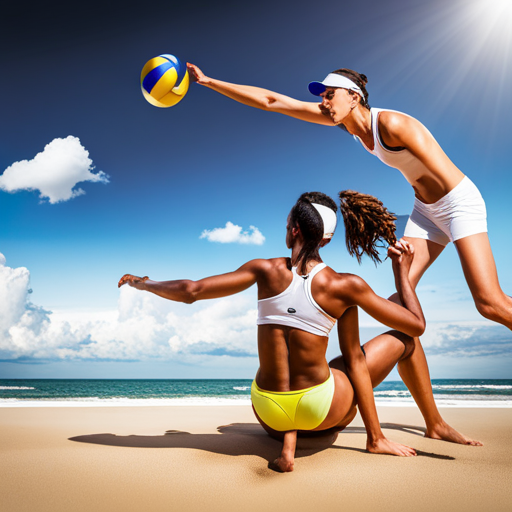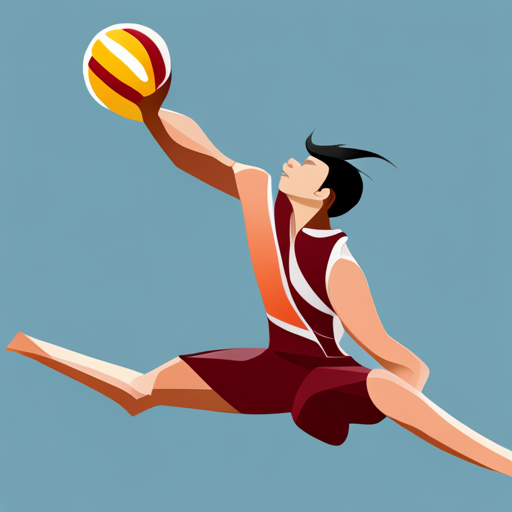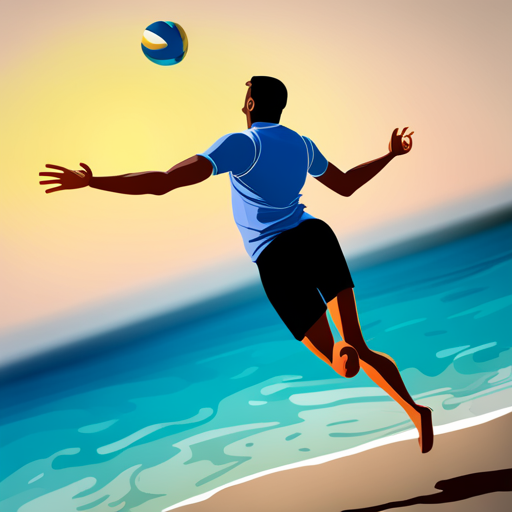Are you looking to up your beach volleyball game? If you’re tired of feeling like you’re not quite hitting your full potential on the sand, it’s time to step up your strategy and skills. With the right tips and tricks, you can take your beach volleyball game to the next level.
One of the most important things to keep in mind when it comes to beach volleyball is the importance of strategy. This isn’t just about hitting the ball as hard as you can; it’s about thinking ahead, anticipating your opponent’s moves, and working as a team. With a solid strategy in place, you’ll be able to stay one step ahead of the competition and make the most of every play.
So, whether you’re a seasoned beach volleyball player or just starting out, read on for nine tips and tricks to help you take your game to the next level.
Key Takeaways
– Importance of strategy, teamwork, mental prep, and communication
– Mastering the serve: varying toss, adding spin, and practicing
– Improving passing: proper hand position, footwork, and anticipation
– Pros of improving footwork: faster reaction time, greater agility, improved balance, better overall performance, enhanced endurance and stamina
Importance of Strategy in Beach Volleyball

You gotta have a strategy, bud, if you wanna dominate the sand court and leave your opponents scratching their heads in confusion.
Beach volleyball is not just about hitting the ball back and forth. It’s about teamwork strategies and mental preparation.
Teamwork strategies involve knowing your partner’s strengths and weaknesses and using them to your advantage. You should know when to set up your partner for a spike and when to take the shot yourself.
Communication is key in beach volleyball, and you need to work on non-verbal cues to let your partner know what you’re thinking.
Mental preparation is equally important. You need to be focused, confident, and ready to handle the pressure. You need to visualize your success and stay positive even when things don’t go as planned.
In short, you need to have a game plan and stick to it.
Master the Serve

Want to ace your serve? Try mixing up your toss and adding a bit of spin to throw your opponent off guard. Serve accuracy is crucial in beach volleyball, especially when serving under pressure. Here are three tips to help you master the serve:
1. Vary your toss: Change up the height, speed, and placement of your toss to keep your opponent guessing. This will make it difficult for them to anticipate where your serve will go, giving you an advantage.
2. Use spin: Add spin to your serve to make it more unpredictable. A topspin serve will dip down quickly, making it challenging for your opponent to return. A sidespin serve will curve in the air, making it harder for your opponent to predict where it will land.
3. Practice, practice, practice: The more you practice your serve, the more confident you’ll feel when serving under pressure. Take the time to perfect your technique and experiment with different types of serves to find what works best for you. Remember, a powerful serve can be a game-changer in beach volleyball.
Improve Your Passing

To improve your passing in beach volleyball, you need to focus on three key points:
1. Proper hand position: make sure you’re forming a platform with your arms and hands, keeping your thumbs and fingers together.
2. Footwork: it’s important to stay light on your feet and move quickly to get in position for the pass.
3. Anticipating the ball: read the server’s body language and adjust your position accordingly.
By mastering these techniques, you’ll be able to improve your passing and take your beach volleyball game to the next level.
Proper Hand Position
When playing beach volleyball, it’s crucial to maintain a proper hand position for optimal control and accuracy in your shots. Your hand placement should be on the ball’s center so that it’s easier to control the direction and speed of the ball. Your fingers should be spread out to cover as much surface area as possible, giving you better control.
Here are four tips to help you maintain a proper hand position:
1. Keep your wrists straight and firm to prevent the ball from going in the wrong direction.
2. Use your fingers to control the ball’s direction and speed.
3. Make sure your grip strength is strong enough to handle the ball’s weight and speed.
4. Practice maintaining a proper hand position consistently to avoid making mistakes during the game.
By following these tips, you’ll be able to improve your control and accuracy, making you a more effective player on the court. Remember, maintaining a proper hand position is just one aspect of the game, but it’s an important one that can make all the difference in your performance. Keep practicing and pushing yourself to improve, and you’ll see the results in no time.
Footwork
Improving your footwork is essential in becoming a more agile and efficient player on the sand, remember: practice makes perfect. Beach volleyball requires players to be quick on their feet and make split-second decisions, so having good footwork can make all the difference in winning or losing a game. The first step in improving your footwork is to focus on balance training. This involves practicing exercises that improve your balance, such as standing on one foot or using a balance board. By improving your balance, you’ll be able to move more efficiently and with greater stability on the sand.
Another way to improve your footwork is to incorporate agility drills into your training. These drills are designed to increase your speed and reaction time, making you more agile and responsive on the court. Some examples of agility drills include ladder drills, cone drills, and jumping drills. By regularly incorporating these drills into your training regimen, you’ll be able to move quickly and efficiently on the sand, giving you an edge over your opponents.
It’s also important to remember the importance of proper footwear when it comes to improving your footwork. Beach volleyball requires shoes that provide good traction on the sand, as well as support and stability for your feet. Investing in a good pair of volleyball shoes can make all the difference in your ability to move quickly and efficiently on the court. Remember, the key to improving your footwork is to practice regularly and focus on balance training and agility drills. With dedication and hard work, you can become a more agile and efficient player on the sand.
| Pros of Improving Footwork | Cons of Neglecting Footwork | ||
|---|---|---|---|
| ————————— | —————————– | ||
| Faster reaction time | Inability to chase down balls | ||
| Greater agility on court | Difficulty in changing direction | ||
| Improved balance | Increased risk of injury | ||
| Better overall performance | Limited mobility | Enhanced endurance and stamina | Reduced power and strength |
Anticipating the Ball
You can’t afford to miss a single opportunity to score, and that means anticipating the ball like a pro. Ball prediction is one of the key skills that separate the great players from the average ones. It’s all about reading the body language of your opponents, analyzing their movements, and predicting where the ball is going to land.
To master this skill, you need to practice a lot, and focus on the following techniques:
– Pay attention to the hitter’s approach: This will give you an idea of the angle and power of the shot. The faster the approach, the more likely it is to be a hard hit.
– Watch the setter’s hands: The setter’s hands will tell you where the ball is going to be set. If the hands are high, the ball is likely to be set to the front of the court, and if they are low, the ball is likely to be set to the back.
– Position yourself correctly: Your positioning is critical to your ability to anticipate the ball. You need to be in the right place at the right time, which means being aware of your surroundings and adjusting your position accordingly.
By mastering ball prediction and positioning techniques, you’ll be able to anticipate the ball like a pro, and make the most of every opportunity to score. Remember, beach volleyball is all about taking risks and seizing the moment. With these skills, you’ll be able to do just that, and enjoy the freedom that comes with being a great player.
Focus on Setting

When it comes to beach volleyball, focusing on your setting is crucial to upping your game. First, make sure you’ve mastered the proper setting techniques, including hand position and follow-through.
Effective communication with your partner is also key – be sure to establish signals and cues to ensure smooth transitions and avoid confusion.
Finally, pay attention to placement and timing, as these factors can be the difference between a successful set and a missed opportunity. By mastering these skills, you’ll be well on your way to becoming a stronger beach volleyball player.
Setting Techniques
Alright, let’s talk setting – it’s the bread and butter of every beach volleyball game and can make or break your chances of winning, so listen up and get ready to rock the court like a hurricane.
Setting accuracy and ball control are key elements that every great setter must possess. When it comes to setting, it’s all about making quick decisions and having lightning-fast reaction time. You need to be able to read the game and anticipate where the ball is going to land before it actually does.
One of the most important setting techniques is hand positioning. Make sure your hands are above your head and in a diamond shape when you contact the ball. This will give you more control and accuracy over the direction of the set.
Another technique is to use your legs to generate power and height. As you jump and contact the ball, push with your legs to give the set more height and distance.
With these techniques and plenty of practice, you’ll be able to set the ball like a pro and dominate the court.
Communication with Your Partner
Effective communication is crucial for success on the court with your partner. In beach volleyball, where the game is faster and the court is smaller, coordination is essential. You need to be able to communicate effectively to anticipate and react to your opponent’s moves.
To achieve this, you and your partner should establish a set of signals or codes. These signals can be as simple as a hand gesture or as complex as a series of words and movements. The key is to keep it consistent and clear so that you and your partner can understand each other in the heat of the game.
Remember, communication is a two-way street, so make sure to listen to your partner as much as you talk to them. With effective communication and coordination, you and your partner can dominate the court and win more games.
Placement and Timing
Mastering the art of placement and timing in your plays can make all the difference on the court. Improving accuracy and timing for effective shots can help you win more games and become a better beach volleyball player. Here are five tips to help you improve your placement and timing:
– Pay attention to the position of your opponents: Knowing where your opponents are standing on the court can help you determine where to place your shots. Aim for open spots on the court where your opponents are not positioned.
– Use your peripheral vision: Keep an eye on your partner and your opponents while you’re setting up for your shot. This will help you adjust your shot based on their positions and movements.
– Practice your approach: Your approach to the ball can impact your accuracy and timing. Practice your approach until it becomes second nature, so you can focus on placing the ball where you want it.
– Vary your shots: Don’t always go for the same shot every time. Mix up your shots to keep your opponents guessing and to make it more difficult for them to defend.
– Communicate with your partner: Good communication with your partner can help you both anticipate each other’s movements and make more effective shots.
By incorporating these tips into your game, you can improve your placement and timing, and ultimately become a more successful beach volleyball player. Remember to practice consistently and stay focused on the game.
Nail Your Hits

You’ve got the power, now it’s time to unleash it on the sand and make those hits sing like a symphony. Hit accuracy and power are the key elements that can turn the game in your favor.
To achieve this, you need to focus on your technique for spiking. To nail your hits, you need to develop a strong approach. Take small, quick steps towards the ball, and jump off both feet at the same time. As you jump, keep your arm straight and swing it back as far as you can before driving it forward to hit the ball.
Remember to keep your eye on the ball and make contact with the center of your hand. You want to hit the ball with the heel of your hand, not your fingertips or palm. With practice, you’ll be able to add more power to your spike and hit with greater accuracy, making it harder for your opponents to defend.
Work on Your Block

Improving your blocking skills is essential to dominating the net and scoring points in every game. As a beach volleyball player, you need to master the art of blocking in order to become a formidable opponent. Here are some blocking techniques that you can use to up your game:
| Blocking Techniques | Common Mistakes to Avoid | How to Effectively Communicate with Your Partner during Blocking |
|---|---|---|
| Watch the hitter’s shoulder | Jumping too early | Use hand signals to indicate blocking strategy |
| Keep your arms and hands high | Not penetrating the net | Verbally communicate any adjustments during the game |
| Stay balanced and on your toes | Turning your head away from the hitter | Always be aware of your partner’s movements |
| Press over the net | Not staying low | Anticipate your partner’s movements |
| Maintain eye contact with the hitter | Not timing your jump | Encourage and support your partner |
Remember that blocking is not just about physical ability, but also about communication with your partner. Make sure to discuss your blocking strategy before the game and communicate any adjustments during the game. By mastering these blocking techniques and avoiding common mistakes, you can effectively dominate the net and score more points in every game.
Enhance Your Defense

To enhance your defense in beach volleyball, you need to focus on three key points: proper footwork, reading the hitter, and diving and rolling.
When it comes to footwork, make sure you stay light on your feet and move quickly to get in position.
Reading the hitter is crucial for anticipating where the ball is going to go, so pay attention to their body language and aim.
Finally, diving and rolling is a necessary skill for making those tough digs, so practice getting low and rolling out of your dives to avoid injury.
Keep these tips in mind and you’ll be a force to be reckoned with on the court.
Proper Footwork
When playing beach volleyball, it’s crucial that you’re constantly aware of your footwork and positioning on the sand. Proper footwork is essential to maintaining balance and agility, which are both crucial to being an effective player.
Here are some tips to ensure that your footwork is up to par:
– Keep your weight evenly distributed on both feet.
– Take small, quick steps rather than large, slow ones.
– Plant your feet firmly in the sand for stability.
– Avoid crossing your feet, which can throw off your balance.
Common mistakes to avoid include taking too many steps or not moving your feet at all. It’s important to find a balance between being quick and precise with your movements.
Remember, your footwork is the foundation of your game, so take the time to practice and perfect it. By doing so, you’ll be able to move more efficiently on the sand and make plays that you might not have been able to before.
Reading the Hitter
As you’re standing at the net, watching the hitter take their approach, you’ll want to focus on their body language and movements to anticipate where they’ll hit the ball. Hitter analysis is a crucial skill in beach volleyball that can help you make more effective blocks and digs.
Look for cues such as the hitter’s arm swing and shoulder rotation to determine where they’ll hit the ball. If they’re winding up for a cross-court shot, their shoulder will rotate towards the line, and if they’re aiming for a line shot, their shoulder will rotate towards the cross-court.
Effective communication with your partner is also key in reading the hitter. Partner cues can provide valuable information that can help you anticipate where the ball is going. For example, your partner might call out “line”or “cross”to indicate where they think the ball is going.
Additionally, paying attention to your partner’s movements can also give you clues about where the hitter is aiming. Always be aware of your partner’s position and movements so you can work together to make successful plays.
By mastering hitter analysis and effective communication with your partner, you can take your beach volleyball game to the next level.
Diving and Rolling
You can improve your defensive skills by mastering diving and rolling techniques, which increase the likelihood of successfully digging the ball. These techniques require precision and quick reflexes, and when executed correctly, can make all the difference in a game. Technique refinement is key to mastering diving and rolling, as well as injury prevention.
To help you better understand the mechanics of diving and rolling, here’s a table that breaks down the steps involved in both techniques:
| Diving | Rolling |
|---|---|
| Start by taking a quick step forward with one foot | Begin by falling forward onto your side |
| Extend your arms out in front of you and aim for the ball | Use your arms to cushion the impact of your fall |
| Keep your eyes on the ball and tuck your chin to your chest | Roll onto your shoulder and use your legs to help propel you forward |
| Use your momentum to slide along the sand and get back up quickly | Roll onto your back and push yourself up with your arms and legs |
Remember, practice makes perfect when it comes to diving and rolling. Start by practicing on a soft surface, like a mat or grass, before moving onto sand. By mastering these techniques, you’ll not only improve your defensive skills, but also reduce your risk of injury while playing beach volleyball.
Improve Your Fitness

To improve your fitness for beach volleyball, there are three key areas you should focus on: cardiovascular endurance, strength training, and agility/speed.
To improve your cardiovascular endurance, consider incorporating activities such as running, cycling, or swimming into your workout routine.
Strength training exercises, such as squats and lunges, will help you develop the power and explosiveness needed to excel on the court.
Agility and speed drills, such as ladder drills and cone drills, can help you improve your footwork and reaction time.
By working on these three areas, you’ll be able to take your game to the next level.
Cardiovascular Endurance
Improving your cardiovascular endurance is crucial for dominating the beach volleyball court, as the game requires constant movement and agility. Endurance training is the key to building your stamina and enhancing your body’s ability to perform under pressure.
Here are three tips to improve your cardiovascular endurance:
1. Start with low-intensity exercises: Begin with a low-intensity workout such as walking, jogging, or cycling, and gradually increase the intensity level. This will allow your body to adapt to the demands of the game and prevent any injuries caused by overexertion.
2. Incorporate High-Intensity Interval Training (HIIT): A HIIT workout involves short bursts of intense exercise followed by a period of rest. This type of training is perfect for beach volleyball as it mimics the game’s high-intensity bursts of activity followed by brief periods of rest.
3. Focus on breathing techniques: Proper breathing techniques can help you improve your cardiovascular endurance. Breathing deeply and slowly can help you maintain a steady heart rate and prevent fatigue. Incorporating these techniques into your endurance training will help you stay calm and focused during the game, giving you an edge over your opponents.
Strength Training
Strength training is essential for beach volleyball players looking to up their game. Incorporating resistance training into your workout routine can increase muscular strength by up to 50%, according to a study by the American College of Sports Medicine.
By focusing on resistance training, you can develop the explosive power needed to jump higher, spike harder, and move faster on the sand. One way to incorporate resistance training into your beach volleyball workout is through plyometric exercises.
These exercises involve explosive movements such as jumps and hops that engage your fast-twitch muscle fibers, which are responsible for explosive power. Incorporating exercises like jump squats, box jumps, and lateral bounds into your routine can help you develop the explosive power needed for quick movements on the sand.
By consistently incorporating strength training and plyometric exercises into your workout routine, you can build muscle, increase overall athleticism, and take your beach volleyball game to the next level.
Agility and Speed
Congratulations on completing the previous subtopic on strength training! You’ve already taken a significant step towards improving your beach volleyball game. But, to become a well-rounded player, you also need to focus on agility and speed. These skills are essential to react quickly to your opponent’s moves and cover more ground on the court.
So, let’s dive into some agility drills and speed training techniques that will help you up your game. To improve your agility, start with ladder drills like the lateral shuffle, high knees, and the crossover. These drills will help you improve your footwork and quickness on the court. Additionally, cone drills like the 5-10-5 drill and the T-drill will help you change direction quickly, which is essential in beach volleyball. Incorporating these drills into your practice routine will help you move faster and more confidently on the court.
Here are three benefits of agility and speed training that will motivate you to incorporate them into your practice routine:
– Increased confidence: When you move quickly and react faster, you’ll feel more confident on the court.
– Better performance: Agility and speed training will help you cover more ground and reach the ball faster, leading to better overall performance.
– Injury prevention: Better agility and speed will help you avoid injuries by improving your balance and coordination.
So, add agility and speed training to your practice routine and see the difference it makes in your game!
Stay Hydrated and Nourished

Don’t forget to keep yourself hydrated and fueled with nutritious snacks during long beach volleyball tournaments, it’s essential for optimal performance. When you’re playing under the scorching sun, it’s easy to get dehydrated and lose energy quickly. This can lead to a decrease in performance and even injury. To avoid this, make sure to drink plenty of water before, during, and after the game. You can also add some electrolytes to your water or drink sports drinks to replenish lost fluids and minerals.
In addition to hydration, it’s also important to fuel your body with nutritious snacks. Instead of reaching for sugary or processed snacks, opt for fruits, nuts, and whole-grain snacks that provide sustained energy. You can also bring some protein-rich snacks like hard-boiled eggs or nut butter to help repair and build muscles. By keeping your body hydrated and nourished, you’ll be able to perform at your best and enjoy the game without any setbacks.
| Hydration Tips | Nutritious Snacks |
|---|---|
| Drink plenty of water before, during, and after the game | Fruits |
| Add electrolytes to your water or drink sports drinks | Nuts |
| Avoid sugary or processed snacks | Whole-grain snacks |
| Bring protein-rich snacks to help repair and build muscles | Hard-boiled eggs |
| Nut butter |
Frequently Asked Questions
How do I choose the right partner for beach volleyball?
Choosing the right partner for beach volleyball is like finding the perfect dance partner. Look for someone who shares your team dynamics and communication strategies. Technical skill is important, but chemistry is key. Find your match for ultimate freedom on the court.
What are some common mistakes to avoid in beach volleyball?
To improve your beach volleyball game, avoid common mistakes like not communicating with your partner, hitting the ball too hard, and not moving your feet. Focus on technique and strategy to achieve freedom on the court.
How do I deal with windy conditions during a beach volleyball game?
When the wind is blowing, you need to adjust your game plan. Use wind strategies like hitting lower and harder, and communication techniques like hand signals to stay in sync with your partner. Don’t let the wind control you, take charge and adapt.
Can I wear regular athletic shoes for beach volleyball or do I need special shoes?
For beach volleyball, it’s best to wear shoes specifically designed for sand. Regular athletic shoes can cause slips and falls. Look for options with a grip sole, breathable mesh, and sand-release channels to keep your feet comfortable and stable.
What are some good warm-up exercises to do before playing beach volleyball?
To prepare for any physical activity, it’s crucial to warm up properly. Incorporate dynamic stretches like leg swings and plyometric exercises like squat jumps to activate muscles and improve mobility. This will reduce the risk of injury and improve performance.
Conclusion
Congratulations on taking the first step towards improving your beach volleyball game! By following the tips and tricks outlined in this article, you’re well on your way to becoming a formidable opponent on the sand.
Remember, strategy is key in this sport. Just like a chess player must think several moves ahead, you must anticipate your opponent’s next move and plan accordingly.
One way to stay ahead of the game is to master the serve. A well-executed serve can put your opponent on the defensive, giving you the upper hand.
Improving your passing and focus on setting will also help you control the game. Don’t forget to work on your hits and block, as well as enhance your defense. And of course, fitness is crucial in this high-energy sport. Stay hydrated and nourished to keep your body in top form.
Think of yourself as a sculptor, molding and shaping your game with each practice and match. Just like a sculptor must take their time and work with precision, you must put in the effort to hone your skills and improve your game.
Don’t be afraid to try new techniques and strategies, and always be open to learning from your mistakes. With persistence and dedication, you can achieve greatness on the beach volleyball court.
So go out there and play your best game yet!
